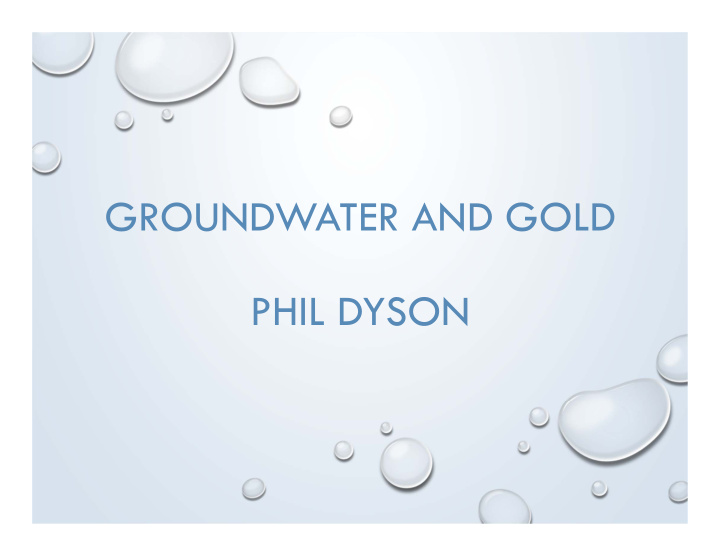



GROUNDWATER AND GOLD PHIL DYSON
Gold discovered in 1851 5,000 mines - highest concentration in the world Average depth 300 – 600 metres Many beyond 1,000 metres Victoria hill 1400 metres
IN THE BEGINNING In the beginning: Sediments accumulate on the floor of the Ordovician Sea in Eastern Gondwana between 487 and 442 million years ago
GONDWANA
Turbidites Eastern Sediment rests on the continental shelf ahead Gondwana of flowing down submarine canyons and stratifying over the deep ocean floor Continental shelf Of the order of !0 Stratified layers of sediment kilometres Thousands of metres of sand, silt and mud Deep ocean floor Hundreds of kil
Graptolites rapidly evolve and inhabit the surface of the ancient ocean. When they die they fall to the deep ocean floor and are buried in layers of sediment The species present establish the age of the old rocks with certainty 3 – 4 Km Darawillian Yapeenian Up to 6,000 metres Castlemanian 487 - 442 million years of sediment Chewtonian Bendigonian Lancefieldian
FOSSIL HUNTING
GRAPTOLITE FOSSILS
GRAPTOLITES
FOLDING - CRUSTAL SHORTENING IN THE LATE ORDOVICIAN
FOLDED ROCK
MARINE SEDIMENT LAYERS NEAR VERTICAL
BEDROCK
Anisotropic Fractured Rock Aquifer Folding leads to fracturing which is greatest in fold axes and fault zones Fractures are generally only open to a depth of 50 to 100 metres. Beyond this depth they are closed because of overburden pressures. Groundwater flow is, accordingly, usually much greater in a north-south direction (into the diagram) than it is in an east-west direction (across the diagram).
LOCAL SHEAR ZONES
Quartz Reefs, Gold Quartz and Mining Reefs Quartz reefs rich in gold form in fracture zones in fold axes Reef mining along north-south anticlinal axes reinforces preferential groundwater flow along north-south fold axes The field fills with groundwater and almost every significant drainage depression becomes a saline groundwater discharge area Significant groundwater discharge occurs as the northerly flow down the old workings discharges to the Myers Creek
Groundwater migrates through underground tunnels Old workings become underground drains that greatly enhance the northward flow of groundwater along anticlinal axes
BENDIGO GOLDFIELD 1923
GROUNDWATER DISCHARGE ESTIMATED WATERTABLE DEPTH
CHEMISTRY SALINITY: • 5,000 – 10,000 MG/L • 1 TO 2 TEASPOONS IN A LITRE OF WATER • OR 5 TO 10 TONNES PER ML • SEA WATER IS 35,000 MG/L • IRRIGATION WATER <1,500 MG/L ARSENIC: • 2- 6 MG/L • 2 – 6 KILOGRAMS PER ML • USA EPA PROTOCOL FOR DRINKING WATER IS 0.01 MG/L
GROUNDWATER DISCHARGE TO BENDIGO CREEK
GROUNDWATER DISCHARGE TO BENDIGO CREEK
BAY STREET GOLDEN SQUARE 2007
BAY STREET GOLDEN SQUARE 2007
GROUNDWATER DISCHARGE TO BENDIGO CREEK
SALT FORMED THROUGH EVAPORATION OF SALINE GROUNDWATER
SALT DAMAGE
GROUNDWATER MANAGEMENT
GROUNDWATER MANAGEMENT
GROUNDWATER MANAGEMENT
GROUNDWATER MANAGEMENT
Recommend
More recommend